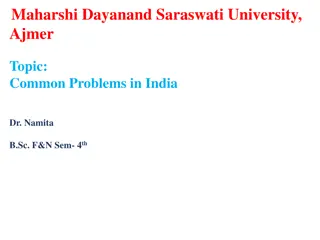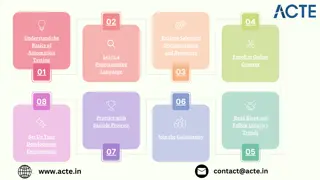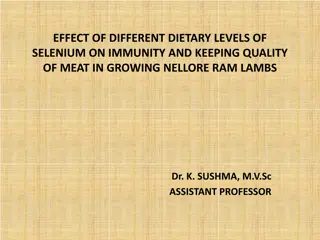Insights into Micronutrient Deficiencies in Geriatrics: B12, Zinc, Selenium, Vitamin D, Iron, and Pharmaceutical Interventions
This presentation by Kate Walker, MD, RDN, LDN, CSG, provides detailed information on high-risk micronutrient deficiencies in older adults, focusing on B12, Vitamin D, and Zinc. It covers the identification of deficiencies, signs, symptoms, and updated recommendations for supplementation. Discussion includes the roles and deficiency implications of B12, complex digestion, absorption processes, potential issues, and factors affecting absorption. Valuable insights are shared on pharmaceutical interventions and strategies to address deficiencies in the geriatric population.
Download Presentation

Please find below an Image/Link to download the presentation.
The content on the website is provided AS IS for your information and personal use only. It may not be sold, licensed, or shared on other websites without obtaining consent from the author.If you encounter any issues during the download, it is possible that the publisher has removed the file from their server.
You are allowed to download the files provided on this website for personal or commercial use, subject to the condition that they are used lawfully. All files are the property of their respective owners.
The content on the website is provided AS IS for your information and personal use only. It may not be sold, licensed, or shared on other websites without obtaining consent from the author.
E N D
Presentation Transcript
Micronutrient deficiencies in geriatrics (B12, zinc, selenium, vitamin D, iron) and pharmaceutical intervention options KATE WALKER, MDA, RDN, LDN, CSG Assistant Professor of Practice and Dietetic internship Clinical Instructor, Simmons University
Objectives 2 Identify high risk micronutrient deficiencies in older adults: B12, Vitamin D and Zinc. Recognize signs and symptoms of deficiency on these micronutrients. Updated practice recommendations for micronutrient supplementation
Vitamins overview 3 The older adults at increased risk for vitamin and mineral deficiencies. Decreased appetite Food insecurity Poverty Medication Functional decline Decreased digestive enzyme production Advanced chronic illness
Vitamin B12 4 B12 Digestive Carrier Proteins: R-Protein (salivary, pancreatic) Intrinsic Factor (parietal) B12 Serum Carrier Proteins: Holotranscobalamin (holoTC) AKA Active B12 10-30% of serum B12 Holohaptocorrin (holoHC) 70-90% of Serum B12 1, 2
Roles and Deficiency 5 Roles of B12 Deficiency Coenzyme that converts homocysteine to methionine In tandem with dietary folate Adequate folate and inadequate B12 can mask B12 deficiency DNA synthesis Make new RBCs Fatty Acid Metabolism Cofactor: S-adenosylmethionine (SAMe) Production Methylmalonyl-CoA mutase Pernicious anemia Megaloblastic anemia Demyelinating neurological disease 4,5
Complicated Digestion & Absorption 6 Duodenum: Pancreatic proteases and bicarb B12 freed from R protein. IF activated B12-IF Absorbed at distal ileum Cubam receptor Endocytosis Only if bound to IF. Mouth: B12-P in food Salivary R-protein Stomach: HCl activates pepsin Pepsin frees B12 from P-protein B12-R Intrinsic factor 2,4
A Lot Can Go Wrong! 7 Stomach lining integrity/resections Parietal cells IF production Biliary or pancreatic dysfunction Bicarbonate fluid Pancreatic proteases Bacterial overgrowth Can rob B12 Inflammation Ilium Absorption integrity /resections Poor intake of B12 rich foods (Meat , Poultry , Fish, Shellfish (clams and oysters), Egg yolk Lactose Intolerance Food access, $$ Therapeutic diets Chewing/swallowing difficulties Kitchen ADLs Malnutrition Protein structure synthesis (IF, R protein, enzymes, blood carrier proteins) Decreased HCl HCl Production Zollinger-Ellison syndrome (ZES) 1,2,3,4
Pharmacological Risks 8 Proton Pump Inhibitors & H2 Receptor agonists1,4 Decreased removal of food protein from B12 Front-line protection from bacteria in the gut Metformin3,4,6 Intestinal motility, bacterial overgrowth, reduced uptake of B12 in Ileum. Nitrous oxide abuse7 Irreversibly inactivates cobalamin Colchicine1 May disrupt cubam receptors May decrease IF production Cholestyramine1 May decrease intestinal absorption
Signs and Symptoms of B12 deficiency 9 Mild deficiency: Fatigue Anemia Moderate Deficiency Macrocytic anemia Burning/ sore tongue Mild/subtle neurological features Severe deficiency Bone marrow suppression Macrocytic anemia Clear neurological features Shiny, smooth, beefy tongue Burning/ sore tongue Jaundice NFPE Pale conjunctiva Pale oral mucosa/tongue Glossitis (Beefy red, smooth, sore) Peripheral neuropathy Confusion Muscle discoordination 1,8
B12 Deficiency Testing 10 Morphological features MCV >100 And/or RDW RBC /- Hgb Hct MCH WBC /- Platelets /- Hyper segmented neutrophils Pancytopenia (severe) Total serum B12 < 200ng/dL is sensitive enough to Dx to 97% accuracy Normal low-intermediate levels should be further evaluated Can take years of deficiency before it shows in serum value. 10-30% HoloTC-bound Delivers to all tissues 70-90% Holo-HC-bound Delivers to liver only. 1,2,4,8
B12 Deficiency Testing 11 2 of 4 test measures will provide diagnostic specificity and sensitivity more that any one measure alone. MMA Accumulation occurs in the absence of B12 Conversion of methylmalonic acid to succinyl-CoA requires B12 cofactor. Serum B12: <200ng/dL to intermediate-normal values Methylmalonic acid (MMA): >0.56umol/L Homocysteine (Hcy): >15 umol/L >20umol/L in >65y/o Holo-TC: <20 pmol/L Hcy Sensitive but non-specific Folate, B6, renal failure and hypothyroidism. Holo-TC Suggested norm: 20-134 pmol/L Potentially more sensitive marker of B12 status Unclear guidance for deficiency thresholds 1,2,4,8
B12 Supplementation 12 Sublingual and nasal administrations also available Only small cohort studies IM supplement 1000 ug daily or every other day for 1-2 weeks Wean down to once monthly or to daily oral supplements. ~10-15% retained Prophylactic tx may be warranted In altered GI anatomy Folate 5mg/day shortly after starting B12 repletion Oral Supplements 1,000 ug to 2,000 ug per day Can be as effective as IM 1-4% absorbed Not recommended for severe depletion or malabsorption. Monitor: CBC: 1-2wks 8 weeks Potassium MMA/Hcy: 2 wks Folate, Iron Neurological symptoms: 1-2 mo Don t monitor Serum B12 1,4,10
Iron 13 Absorbed in small intestine Becomes structural part of hemoglobin. Diet: Red meat, poultry, dark leafy greens, legumes. Heme-Iron vs Non-Heme Iron. Ascorbic acid (vitamin C) bioavailability of non- heme iron. Phenols bioavailability by as much as 60%.
Roles and Deficiency 14 Roles Deficiency Oxygen transport Hemoglobin, myoglobin DNA synthesis RBCs Enzymatic activity Mitochondrial function Neurotransmitter production and function IDA Microcytic anemia Weakness, lethargy, poor endurance. Absolute IDA Functional IDA 11, 13, 14
Deficiency Risk 15 Poor Intake Iron rich foods Vit C rich foods High intake of non-heme competitors Phytates, Tannins Chronic Illness Renal disease Hemodialysis treatment Inflammatory conditions Small bowel integrity GIB Age >80y/o Possibly related to decreased Human growth hormone production Pharmaceutical Calcium Magnesium PPIs/H2 blockers 11, 12, 13
Iron Deficiency Testing 16 Iron Studies Ferritin <12ug/L With CRP or AGP <50 ug when inflammation present Transferrin <15 % Total Iron- not reliable Bone Marrow Iron is gold standard Invasive but can still be useful in complex cases Hematology Hgb Hct RBC MCV Platelets Elongated, pencil shaped cells Hypochromic cells % Reticulocyte count 11,12, 13, 14
Treatment 17 IV iron Ferric carboxymaltose Iron sucrose May improve QOL for CHF patients ESRD: may improve mortality/morbidity from cardio events Still concern for microbial growth Avoid use in sepsis, critically ill patients Monitor: Hgb 4-6 wks Phosphorus (for ferric carboxymaltose) Traditionally 100-200mg elemental Iron per day Supplements vary in bioavailability. Fumarate: 33% Sulfate: 20% Glucinate: 12% Citrate: n/a Emerging studies show less is more Absorption GI side effects Alternating days Smaller doses result in similar repletion results 11,12, 13, 14
Vitamin D 18 D2 and D3 found in food Food Sources Fatty fish Beef, veal, liver Egg yolk Fortified dairy products Fortified orange juice Similar in structure to lipids Absorbed through the same pathway as dietary fat. D3 synthesized in the skin with exposure to UV rays.
Vitamin D 19 D2 and D3 found in dietary sources D3 synthesized in the skin with exposure to UV rays. Similar in structure to lipids Absorbed through the same pathway as dietary fat.
Roles of Vitamin D 20 Calcium absorption and homeostasis Bone density PTH regulation Immune function Many areas of ongoing research and controversy Depressed mood disorders Alzheimer s Dementia Cognitive decline Modulation of cell growth Muscle function Immune system Diabetes prevention / treatment Cancer prevention
Risk for Vit D deficiency in elderly population 21 Decreased dietary intake Meat and meat products Dairy products Decreased sun exposure Poor absorption Altered GI structure Poor fat digestion Pancreatitis Biliary issues
Links to All Cause Mortality? 22 2022: A five-year Australian randomized controlled trial compared supplementation with 60,000 IU Q/mov to placebo in over 21,000 community dwelling, healthy adults >60 y/o. Supplementation did not reduce all-cause mortality. 15
Vit D and Fall Risk 23 Several meta-analyses have found that only Vit D + calcium supplementation may reduce risk of fall. 2021 meta analysis included 31 studies Vitamin D alone was not associated with a reduced fall risk in all participants Groups with vitamin D + calcium 12% reduction in falls Except subgroup with baseline below 20ng/mL 23% reduction in fall risk. Too much vit D associated with increased falls 2010 double-blind placebo controlled trial 2256 community-dwelling women, aged 70 years or older received annual 500,000IU Vit D dose for 3-5 years. Fall risk increased in vit D group A 2017 randomized clinical trial 273 postmenopausal women and found a dose response effect: 4,000IU /d associated with increased risk of fall post treatment 25(OH)D level of 41 ng/mL asso with increased fall. lowest fall risk with doses between 1600 to 3200 IU daily. Decreased fall risk with people with history of falls 15, 16, 17, 18
Vitamin D Status and COVID-19 24 Michael, W. et al: Dec 2022. LINK: https://doi.org/10.3122/jabfm.2022.220115R1 Known roles in modulating inflammatory an immune response. Vitamin D deficiency is associated with increased risk of COVID-19 infection. A 2021 meta-analysis including data from 612,601 patients demonstrated that among patients with vitamin D deficiency, the risk of COVID-19 infection was higher than in vitamin D replete individuals, with an odds ratio of 1.26 (95% CI, 1.19 1.34; P .01).32 This finding was confirmed by subsequent meta- analyses. Chiodini et al: Severe deficiency, deficiency and insufficiency of vitamin D were all associated with COVID-19 related hospitalization, ICU admission, and mortality. Bassatne et al:similar trends but not statistically significant Associated with a small reduction in risk of acute URI. A Cochrane review did not find evidence that vitamin D supplementation affected outcomes in all patients with COVID-19. 19
Deficiency Testing 25 Serum level total vitamin D 25(OH) is considered a strong indicator of vitamin D status. Half life ~15 days <12 ng/dL = deficiency Comprised on both 25(OH)D2 and 25(OH)D3 Consider supplementation in elderly patients for for <20ng/dL, some suggest 32ng/dL To minimize bone resorption May be falsely increased during inflammation 8, 21
Vit D Supplementation 26 50,000 IU per week over 6-8 weeks Re-check and adjust as needed. Prolonged aggressive Vit D repletion can cause hypercalcemia. Vit D2 and Vit D3 May be equally effective D3 increases 25(OH)D3 more quickly. D2 may decrease 25(OH)D3 Consider Calcitriol for CKD and ESRD. PTH phosphate and calcium When Vit D 25(OH) is at goal, step down to daily Vit D of at least 600IU/day. 1,000 IU to 2,000 IU per day may be more appropriate for elderly population. Monitor: Vit D 25(OH) PTH Sunshine or UVB lamp 20,21
Zinc 27 Absorbed in duodenum and proximal jejunum. Enhances with citric acid Decreased with iron, fiber and phytates. Total body zinc is ~2g. >95% is intracellular Primarily stored in skeletal muscle and bone ~10% in the liver serve as functional pool. Bound to albumin and alpha 2 macroglobulin in blood stream. Serum= approx 0.1% of body total Daily needs (adults): US: RDA is 8-11mg/day Strict vegetarians may require 50% more Zn. Food sources: Shellfish (esp oysters and lobster) Red meat Mushrooms Nuts and seeds Legumes GI net loss ~2-4mg/day. Shed with GI enterocytes. Bile excrete of Zn ~4ug/mL Enterohepatic circulation. 22, 23
Roles of zinc 28 Component of ~300 metalloenzymes requied for CHO, Pro & fat metabolism Carbonic anhydrase Alkaline phosphatase Alcohol dehydrogenase DNA polymerase Protein chain elongation factor Maintenance of plasma IGF-I even when energy intake is adequate. Vision Vit A transport component of retinol binding protein (RBP) Rhodopsin synthesis. Tissue growth Function in protein synthesis. Regulatory roles Transcription in DNA synthesis Cell signaling Hormone release Apoptosis Thymulin hormone is zinc-depended Involved in T-Cell formation. 22,23
Zinc Deficiency 29 Acute deficiency in elderly adults is more prevalent than originally thought. Thought to be between 6%-15%. Prevalence measures are challenging due to limitations of good zinc status marker. in acute phase response Moves into RBCs and into extravascular space with albumin. Obesity, Cancer Serum zinc is unreliable marker of zinc status but it is the best we have to work with. Homeostasis is excellent. Can be interpreted more reliably when CRP is <15mg/L. Normal value: 70-160 ug/dL CRP 15mg/L=10% decrease, CRP 100-200mg/L=40-60% decrease. 22, 23
Who is at risk? 30 Inadequate intake >3 months of poor nutrition. Suboptimal baseline nutrition followed by 1-2 weeks of extremely poor nutrition. TPN administration for >1 week without zinc supplementation Increased needs Systemic infection, wound healing, cancer, oxidative stress. Increased losses/reduced absorption GI: IBS, diarrhea, fistula, chyle leak, Crohn s, short bowel, pancreatic disease. Skin: Burns Urine: Burns, renal Dz, sepsis, trauma, ETOH. Medications: Thiazides, penicillamine, Valproate, ARBs, ACE- inhibitors, EDTA. Hepatobiliary issues ; Biliary drain Decreased skeletal muscle 22,23, 24
Pharmacological Risk 31 Hemofiltration Thiazide diuretics release of zinc in the urine & urine output Especially in liver disease Sodium valproate Zn + Se supplementation with this Rx may prevent hepatotoxicity by addressing oxidative stress Iron supplementation Competes for intestinal absorption 22,23, 24
Focus on clinical signs and symptoms 32 Severe Zn Deficiency Moderate Zn Deficiency Overt hypogeusia/ageusia. Persistent, unexplained anorexia. Skin issues Worsened wounds New decub ulcers Seborrheic dermatitis Scalp, mouth, nose. Alopecia Angular blepharitis Beau s Lines. Behavioral disturbance, memory impairment. Metallic taste or slightly blunted taste. Decreased appetite. Diarrhea Skin issues Slow/poor wound healing New unexplained rash/eczema 8, 22, 23,
Supplementation 33 Zinc sulfate 220mg x 10-14 days monitor for clinical changes. 250mg=60mg elemental zinc. Toxicity is rare Observed as result of single mega-doses but not prolonged Zn supplementation. >1200 ug/dL=toxicity Prolonged supplementation of >50mg/day can cause copper deficiency. Compete for same receptors for absorption 8, 22, 23
Selenium 34 Absorbed into via Se-related transporters in the distal ileum Uptake in the liver may serve as a long-term storage incorporated into selenoprotein P (SELENOP). Delivers Se to body tissues Enters tissues via low-density lipoprotein receptor-related protein 8 (LRP8) Components of selenoproteins Many selenoproteins are thought to serve as valuable antioxidants May play role in maintaining normal LDL cholesterol Too much or too little elevates LDL Food sources: Brazil nuts fish and shellfish Organ meats poultry meat 25, 26, 31
Selenium Emerging Research 35 Promising preliminary inverse correlations Cardiovascular health Age-related cognitive decline Parkinson s disease Beneficial effect seen in populations with low baseline Se 1996 American study 1312 mAge 63y/o with h/o BCC or SCC 200 g Se/day x 8 yrs Results of decreased the risk of CA incidence by 37% colorectal 58% prostate 63% lung 48% 2009 Study 35,500 mAge 63 200ug Se/day & 400IU Vit E/day x 5 years Possible cancer connection 2020 (China) meta analysis Daily intake >55ug/day decreased risk of some CA 1984 Finland started Se fertilizer supplementation 1995 study noted reduction in CA mortality Inverse associations noted with some cancers Over-supplementation may increase CA risk 27, 28, 29, 30
Assessment of Risk 36 Pharmacological Deficiency Risk Hemodialysis Removed with tx Anticoagulants Se slows clotting Immunosuppressants and cortico steroids May decrease effect Barbituates May increase sedative effect Statins If taking Se +beta carotene, Vit C and Vit E can reduce efficacy Low intake Live in regions with low Se soil content Gastric bypass Duodenum and Jejunum integrity 25, 26, 31
Selenium testing 37 NFPE: Mees Lines Hypopigmentation Toxicity symptoms: Brittle Nail syndrome, Peripheral neuropathy Plasma Selenium Norms: 63-160 ug/L <40 ug/L = deficient Glutathionine Peroxidase <10.5 U/mL May be falsely with inflammation Monitor: Glutathione Peroxidase Half-life 1-2 days Don t monitor serum Se, this will increase 2/2 supplementation 8, 32
Se Supplementation 38 Stand alone supplements: Bioavailability studies are sparse Selenomethionine : 90% bioavailable Sodium selenite: 50% bioavailable Selenium-enriched yeast: n/a Sodium selenite: n/a 32
Review 39 Elderly patients are at increased risk for vitamin deficiencies Normal serum B12 may not rule out deficiency Requires further testing Iron deficiency may skew hematology presentation. Serum Vit D remains a reliable marker for deficiency Interpretation of 25(OH)D3 values vary with Pt s age. It is possible to over-supplement. Continued monitoring is necessary. Zinc deficiency is more prevalent than previously thought in acute illness, especially in elderly population. Serum value is not a reliable marker Identifying risk, signs and symptoms and clinical monitoring is recommended.
Questions? 40
References 41 1. Hunt, A., Harrington, D., Robinson, S. Clinical review: Vitamin B12 Deficiency. British Medical Journal. 2014; 349:g5226 Green R. Vitamin B12 deficiency from the perspective of a practicing hematologist. American Society of Hematology. 2017 DOI 10.1182/blood-2016-10-569186. Beulens, J.W.J., Hart, H.E., Kuijs, R. et al. Influence of duration and dose of metformin on cobalamin deficiency in type 2 diabetes patients using metformin. Acta Diabetol 52, 47 53 (2015). https://doi-org.ezproxy.simmons.edu/10.1007/s00592-014-0597-8 Miller,WJ. Proton Pump Inhibitors, H2-Receptor Antagonists, Metformin, and Vitamin B-12 Deficiency: Clinical Implications. Advances in Nutrition. 2018. 9 (4): 511-518. doi.org/10.1093/advances/nmy023. Qudsiya, Zainab. Statpearls.com. Subacute combined degeneration of the spinal cord. Continuing education. Updated 2/12/2023. https://www.statpearls.com/ArticleLibrary/viewarticle/29600#:~:text=A%20deficiency%20of%20vi tamin%20B12%20disrupts%20this%20reaction%2C%20which%20leads,damage%20to%20the%20 myelin%20sheath. Accessed 2/28/2023. Niafar, M., Hai, F., Porhomayon, J. The role of metformin on vitamin B12 deficiency: a Meta- analysis review. Internal and emergency medicine journal. 2014. DOI: 10.1007/s11739-014- 1157-5. Maheshwari M, Athiraman H. Whippets Causing Vitamin B12 Deficiency. Cureus. 2022 Mar 14;14(3):e23148. doi: 10.7759/cureus.23148. PMID: 35308182; PMCID: PMC8923246. 2. 3. 4. 5. 6. 7.
References 42 8. Mordarski, B. Nutrition focused physical exam pocket guide, third edition. Academy of nutrition and dietetics2022 Wang H, Li L, Qin LL, et al. Oral vitamin B12 versus intramuscular vitamin B12 for vitamin B12 deficiency. Cochrane Database Syst Rev 2018;3:CD004655 Wentworth, BJ, Copland, AP. Revisiting Vitamin B12 Deficiency: A Clinician s Guide For the 21st Century. Practical Gastroenterology. 2018. Nutrition issues in gastroenterology series No. 182. Nhlbi.nih.gov (March 24, 2022) Iron deficiency anemia. https://www.nhlbi.nih.gov/health/anemia/iron-deficiency-anemia. Accessed 2/23/2023 Ajmera AV, Shastri GS, Gajera MJ, Judge TA. Suboptimal response to ferrous sulfate in iron- deficient patients taking omeprazole. Am J Ther. 2012 May;19(3):185-9. doi: 10.1097/MJT.0b013e3181f9f6d2. PMID: 21150767. Fairweather-Tait, SJ, Wawer, AA, Gillings, R, Jennings, A, Myint, PK. Iron status in the elderly. Mechanisms of Ageing and Development. 2014. 136 137:22-28. doi.org/10.1016/j.mad.2013.11.005. Pasricha, S, Tye-Din, J, Muckenthaler, MU, Swinkels, DW. Iron deficiency. The Lancet. 2021. 397(10270): 233-248. doi.org/10.1016/S0140-6736(20)32594-0. Michael, W, Couture, AD, Swedlund, M, Hampton, A, Eglash, A, Schrager, S. An Evidence- Based Review of Vitamin D for Common and High-Mortality Conditions. The Journal of the American Board of Family Medicine December 2022, 35 (6) 1217-1229; DOI: https://doi.org/10.3122/jabfm.2022.220115R1 9. 10. 11. 12. 13. 14. 15.
References 43 16. Sanders KM, Stuart AL, Williamson EJ, et al. Annual High-Dose Oral Vitamin D and Falls and Fractures in Older Women: A Randomized Controlled Trial. JAMA. 2010;303(18):1815 1822. doi:10.1001/jama.2010.594 Ling,Y. Xu, F, Xia X, Dai D, Xiong A, Sun R, Qiu L, Xie Z. Vitamin D supplementation reduces the risk of fall in the vitamin D deficient elderly: An updated meta-analysis. Clinical Nutrition. 2021; 40(11): 5531-5537. doi.org/10.1016/j.clnu.2021.09.031. Smith, LM, Gallagher, JC, Suiter, C. Medium doses of daily vitamin D decrease falls and higher doses of daily vitamin D3 increase falls: A randomized clinical trial. The Journal of Steroid Biochemistry and Molecular Biology. 2017. 173: 317-322. doi.org/10.1016/j.jsbmb.2017.03.015. Michael, W. Couture, AD, Swedlund, M, Hampton, A, Eglash, A, Schrager, S. An Evidence- Based Review of Vitamin D for Common and High-Mortality Conditions. The Journal of the American Board of Family Medicine. Dec 2022, 35 (6) 1217-1229. https://doi.org/10.3122/jabfm.2022.220115R1 Melamed, ML, Thadhani, RI. Vitamin D Therapy in Chronic Kidney Disease and End Stage Renal Disease. Clinical Journal or Americal Society of Nephrology. 2012. Feb(7): 358-365. Wilson, L., Tripkovic, L., Hart, K., & Lanham-New, S. (2017). Vitamin D deficiency as a public health issue: Using vitamin D2 or vitamin D3 in future fortification strategies. Proceedings of the Nutrition Society, 76(3), 392-399. doi:10.1017/S0029665117000349 17. 18. 19. 20. 21.
References 44 Sriram, K., Chan, LN. Micronutrients: Assessment of Deficiency and Guidelines for Replacement. American Society for Parenteral and Enteral Nutrition. Clinical Nutrition Webinar Series. 2015 Livingstone, C. Zinc: Physiology, Deficiency, and Parenteral nutrition, ASPEN. 2015.DOI10.1177/0884533615570376 Nematollah, A, Maloos, N, Abdolali, N, Maryam, G, Ehsan, Z, Fatemeh, S. Zinc Deficiency and Oxidative Stress Involved in Valproic Acid Induced Hepatotoxicity: Protection by Zinc and Selenium Supplementation. Biological Trace Element Research. 2017. 179(1): 102-109. https://doi.org/10.1007/s12011- 017-0944-z. Chen C, Jin Y, Unverzagt FW, Cheng Y, Hake AM, Liang C, Ma F, Su L, Liu J, Bian J, Li P, Gao S. The association between selenium and lipid levels: a longitudinal study in rural elderly Chinese. Arch Gerontol Geriatr. 2015 Jan- Feb;60(1):147-52. doi: 10.1016/j.archger.2014.09.005. Epub 2014 Sep 22. PMID: 25263027; PMCID: PMC4260986. Saito, Y. Selenium Transport Mechanism via Selenoprotein P Its Physiological Role and Related Diseases. Frontiers in nutrition. 2021. (8). https://doi.org/10.3389/fnut.2021.685517 Alehagen U, Opstad TB, Alexander J, Larsson A, Aaseth J. Impact of Selenium on Biomarkers and Clinical Aspects Related to Ageing. A Review. Biomolecules. 2021; 11(10):1478. https://doi.org/10.3390/biom11101478 22. 23. 24. 25. 26. 27.
References 45 28. Kuria, A.; Fang, X.; Li, M.; Han, H.; He, J.; Aaseth, J.O.; Cao, Y. Does dietary intake of selenium protect against cancer? A systematic review and meta-analysis of population-based prospective studies. Crit. Rev. Food Sci. Nutr. 2020, 60, 684 694. Clark LC, Combs GF Jr, Turnbull BW, Slate EH, Chalker DK, Chow J, Davis LS, Glover RA, Graham GF, Gross EG, Krongrad A, Lesher JL Jr, Park HK, Sanders BB Jr, Smith CL, Taylor JR. Effects of selenium supplementation for cancer prevention in patients with carcinoma of the skin. A randomized controlled trial. Nutritional Prevention of Cancer Study Group. JAMA. 1996 Dec 25;276(24):1957-63. Erratum in: JAMA 1997 May 21;277(19):1520. PMID: 8971064. Lippman SM, Klein EA, Goodman PJ, Lucia MS, Thompson IM, Ford LG, Parnes HL, Minasian LM, Gaziano JM, Hartline JA, Parsons JK, Bearden JD 3rd, Crawford ED, Goodman GE, Claudio J, Winquist E, Cook ED, Karp DD, Walther P, Lieber MM, Kristal AR, Darke AK, Arnold KB, Ganz PA, Santella RM, Albanes D, Taylor PR, Probstfield JL, Jagpal TJ, Crowley JJ, Meyskens FL Jr, Baker LH, Coltman CA Jr. Effect of selenium and vitamin E on risk of prostate cancer and other cancers: the Selenium and Vitamin E Cancer Prevention Trial (SELECT). JAMA. 2009 Jan 7;301(1):39-51. doi: 10.1001/jama.2008.864. Epub 2008 Dec 9. PMID: 19066370; PMCID: PMC3682779. Marcel CB. Selenium. Pravikoff D RPF, ed. CINAHL Nursing Guide. February 2018. Accessed March 1, 2023. https://search.ebscohost.com/login.aspx?direct=true&db=nup&AN=T706448&site=eds- live&scope=site Selenium Fact Sheet for Health Professionals. National institutes of health, office of dietary supplements. (2021) https://ods.od.nih.gov/factsheets/Selenium-HealthProfessional/. Accessed 3/1/2023 29. 30. 31. 32.























